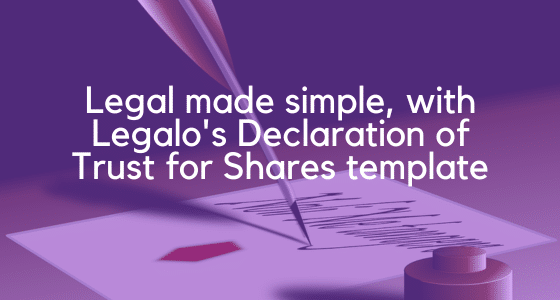Declaration of Trust for Shares
Our Declaration of Trust for Shares template:
- Now over 200 sold!
- Full money-back guarantee
- Expertly drafted
- Short and to the point
- Easy to complete

How Does It Work?
-
1. Download
-
2. Edit
-
3. Print
-
4. Sign
MD, Legalo Ltd; Solicitor; Notary Public
Our Declaration of Trust for Shares template is for use where a nominee holds shares in trust for someone else. Either could be an individual or a company. The Declaration of Trust is short and to the point, making it easy for you to use and quick to complete.
Whenever someone is holding shares on behalf of someone else, so that there is no doubt between them, they should always put in place such a declaration of trust. You can also use this as proof of the trust where needed, e.g. if someone queries the situation, perhaps to claim that the nominee is actually the outright owner (i.e. both legal and beneficial owner).
It is best if you put the declaration of trust in place immediately that the shares become subject to a trust. If you did not do that, then you should sign it as soon as possible afterwards.
Now over 200 sold!
Bare trust
When you have the declaration of trust in place, there is then no real need for the beneficial owner to ask the nominee to transfer the shares to him (although it gives him to the power to require this at any point). As such, this trust deed is a “bare trust”, and not a “discretionary trust” (the latter being a trust where the beneficiary/ies is or are undecided when the declaration of trust is signed, but will come from a group of named people, with the actual beneficiary/ies to be picked in the future.)
Using our Declaration of Trust for Shares template
Once you have purchased the template, you can download it and the short guide that accompanies it from your account with us as Word documents. The guide explains each clause and makes filling in the template easy for you.
David drafted the declaration of trust. He is one of our founders and a very experienced UK solicitor.
When you buy our template, as with all our templates, you will benefit from:
- permanent access to the template from your account;
- free updates to the template forever;
- our free email and telephone helplines to assist you with queries you may have with your account or with using the template; and
- our money-back satisfaction guarantee.
FAQs from the Internet
Below, we have answered the most popular questions from the Internet about this template.
Does a declaration of trust need to be registered with HMRC? Do I need to send declaration of trust to HMRC?
You need to register virtually all trusts with HMRC, even ones that are not liable for tax. This new law took effect on 6 October 2020. You have 90 days from creating the trust to register it. To find out more on this and to register your trust, click here.
What is a declaration of trust for shares?
Where you hold shares in your name but in reality you hold them on behalf of someone, then you should make a declaration of trust. The true owner can then rely on that declaration and can ask you:
- to transfer the shares to them later on;
- to vote in accordance with their wishes; or
- to sell the shares on their behalf.
The declaration can also say that you hold the shares jointly with that other person, or persons, and, if not 50/50, in what percentages.
What should be included in a Declaration of trust?
The declaration of trust for shares should, as a minimum, include the following details:
- identify the true owner of the assets;
- specify the assets involved; and
- if you own the assets jointly, in what percentages each owner owns them.
What is a simple declaration of trust? What is a declaration of trust UK template?
A declaration of trust for shares is the short legal document that confirms that you hold the assets on trust for someone else. Legalo offers this as a great template that is easy to use and quick to complete.
Who makes a declaration of trust?
The person who holds shares in their name on behalf of someone else is the person who makes the declaration of trust for shares.
What happens if you don’t have a declaration of trust?
When you own assets jointly, the assumption is you own them 50/50. If that is not the case, then you need a declaration of trust to correct this and specify the actual ownership percentages. If an asset is not held by the trust owner, then there is a risk that person might pretend it is their own asset unless the true owner has evidence to the contrary. A trust deed or declaration of trust is generally the evidence they need.
How long does a declaration of trust last?
This is a permanent document. It lasts until the nominee who made it no longer holds the shares, because:
- they have sold them and given the sale proceeds to the beneficiary; or
- they have transferred the shares to the beneficiary.
As it is a bare trust, the beneficiary can ask for the shares to be transferred into their name at any point, provided that the beneficiary is aged 18 or older (or 16 or older if the beneficiary is Scottish).
Can I write my own declaration of trust? Does a deed of trust need to be done by a solicitor?
As with all of the templates that Legalo offer, you do not need a solicitor to draft it for you. With our helpful template, you can write it yourself in just a few minutes.
Does a declaration of trust need a witness?
You sign a declaration as a “deed”, so, yes, it does need a witness. The written guide to the template sets out what this means, but, in essence, the witness should:
- not be the beneficiary; and
- be aged 18 or older.
Do you have to pay stamp duty on a declaration of trust?
Not in relation to shares. There would be the normal rate of stamp duty to pay when the person (who later declares a trust over them) buys the shares. Later on, there is no stamp duty to pay when you make the declaration, and there is an exemption from stamp duty on the transfer of shares when you transfer them over to the beneficiary of the trust.
Guide to our Declaration of Trust for Shares
What follows is an excerpt from our guide to this template. The full guide accompanies the template when you purchase it.
The declaration itself is not sent to the company that has issued the shares (as the company is only duty-bound to recognise the owner of the legal title and not who owns the beneficial title).
However you do need to register all new trusts with HM Customs & Revenue, even those that do not incur tax. You have 90 days to register it from the date you signed the declaration. For full details, see the HMRC website at https://www.gov.uk/guidance/register-a-trust-as-a-trustee.
For Wikipedia’s take on what trusts are all about, see: https://en.wikipedia.org/wiki/English_trust_law.
Clauses in this Declaration of Trust for Shares
Below, we have set out the main features of the written guide that accompanies the template. You get the full tax of the guide when you purchase the template.
1. Interpretation
This clause defines the main terms used in the declaration.
- Company – fill in the details to identify the company that issued the shares in question – name and registered number.
- Shares – fill in the details – the number of shares, the class (e.g. “ordinary”), their “par” value (this is the nominal value of the shares, not their current or market value – it is the denomination they were issued in, which is most commonly as £1.00 shares). State whether the shares are fully paid up or part paid, etc.
2. Declaration of trust
This is the main clause in the Declaration of Trust for Shares, which states that the nominee holds the shares in trust for the beneficial owner.
3. Undertaking
Clause 3.1 provides that the nominee will account to the beneficial owner for any dividends due on the shares. Also the nominee will only vote in accordance with the way the beneficial owner directs him to. If the beneficial owner asks for the shares to be transferred, sold, etc, then the nominee will obey. Clause 3.2 provides that, if required, the nominee will sign a stock transfer form for the transfer of the shares. This could act as security for the obligation in clause 3.1 for the nominee to transfer them on request. You would leave the date out of the form and leave the name of the transferee and the price blank. Then the beneficial owner could complete it later and use it to sell the shares.
4. Power of attorney
This gives a power of attorney in favour of the beneficial owner. This protects the beneficial owner in case the nominee does not follow his directions. It acts as further security.





